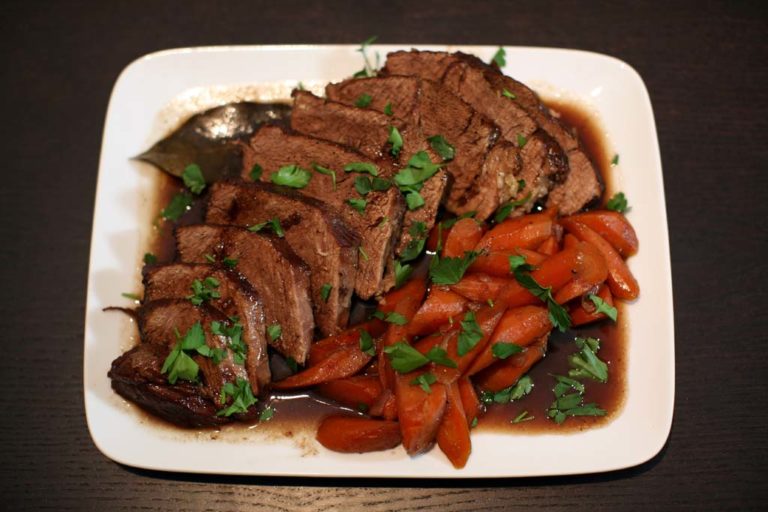
Chef's notes:
Braised beef is made with pieces of meat that would otherwise be chewy and impossible to eat. These include chuck roasts, beef briskets, some rump roasts, shoulder roasts, and arm roasts. These cuts of meat, when partially submerged in a liquid and braised for several hours, become tender and quite delicious. This is because the collagen (which usually makes these roasts tough and inedible) slowly melts away during the long braising process. This is why we use tough cuts of meat for braising. Tender cuts of meat should be cooked other ways. If you braised a tender cut of meat, it would turn into mush. The following is my braised beef chuck roast recipe.
Ingredients
- 2 pounds chuck roast
- Salt
- Black pepper
- ¼ cup bacon
- 1 onion
- 4 carrots
- 5 cloves garlic
- 2 cups beef stock
- 1 cup port
- 1 bay leaf
- 1 sprig thyme
- 4 Tbsp butter
- Fresh parsley
- Water
Braised Beef Chuck Roast Recipe
- Buy the right cut of beef to braise. For this article I purchased a two-pound chuck roast. Since it is small, I will only have to braise it for two to two and a half hours. If it were a three- or four-pound roast, I might braise it for as long as three and a half to four hours. The key to good braised beef is sticking to the tougher cuts of meat which need long, slow and moist cooking. Preheat the oven to 375 degrees F now and season the beef with salt and pepper.
- Prep the veggies and other ingredients for the braised beef. Cut the carrots into large chunks, so they take longer to cook. Mince the onions, so they melt into the sauce. For the garlic, just cut off the dry end and flatten the cloves with your knife. Cut the bacon into thick chunks. The parsley is for a garnish at the end, but chop it up now so it’s ready later. Also, measure out the beef stock and port wine now.
- Brown the beef on all sides. Heat up the braising pan or Dutch oven on the stove top to medium-high heat. Melt four tablespoons of butter in the pan. Begin searing the beef when the butter just starts to turn brown. Sear the beef on all sides until it is dark brown over most of the surface. Remove the beef to a plate while you perform the next step.
- Add the veggies and bacon to the braising pan. Fry the bacon, onions, carrots, and garlic in the pan using a wooden spoon with a flat tip so that you can scrape some of the drippings off of the bottom without destroying your pan. Once the onions begin to turn translucent and the bacon is browned, move onto the next step.
- Add the beef broth and port wine to deglaze the pan. Stir and scrape at the bottom of the pan with the wooden spoon. Turn the heat off on the stove and put the browned beef back into the pan. If the liquid doesn’t go halfway up the side of the beef, add a little water until it does. Put the bay leaf and the thyme in the pan, cover it, and put the pan into the oven. Set the timer for one hour.
- After one hour, remove the braised beef. Make sure to use good oven mitts and be careful not to spill. Set the braising pan down and use an oven mitt to remove the lid. Use a pair of tongs to flip the roast. Put the lid back on and put it back in the oven. Set the timer for thirty minutes. After thirty minutes, flip it again. Then put it back in for thirty more minutes. After that time has elapsed, check the meat to see if it is fork-tender. If it is not, cook in additional thirty minute intervals until it is.
- Rest the braised beef and finish the sauce. Once it is fork-tender, remove the braised beef carefully from the juices and let it rest on a cutting board. Lightly drape or tent some aluminum foil. Remove the vegetables from the sauce with a slotted spoon and put them in the serving dish. Reduce the braising liquid until its thick. If the liquid is already flavorful or too salty, thicken it with a roux or gelatin rather than reducing it. Slice the braised beef and serve it with the vegetables and the sauce. Garnish with parsley.
Tips & Tricks
- Use a good, fresh-looking piece of meat. If you can, try grass-fed meat; it’s leaner and has good fatty acids in it.
- If you have no braising pan or Dutch oven, use a cake pan and cover it with aluminum foil or use a stock pot.
- Don’t worry about trimming the fat off. It’s all good.
- In this beef chuck roast recipe there is no room for Lipton’s onion soup mix.
- Make sure to have an oven thermometer inside of your oven at all times. Oven thermostats are not to be trusted.
- Braised meat dishes work well with lamb or brisket, too.
- Because of the gelatin in the bone, a piece of meat with a bone in it will make a more flavorful sauce.
- Braised meat dishes are made with otherwise chewy pieces of meat that, when braised, become tender and delicious.
